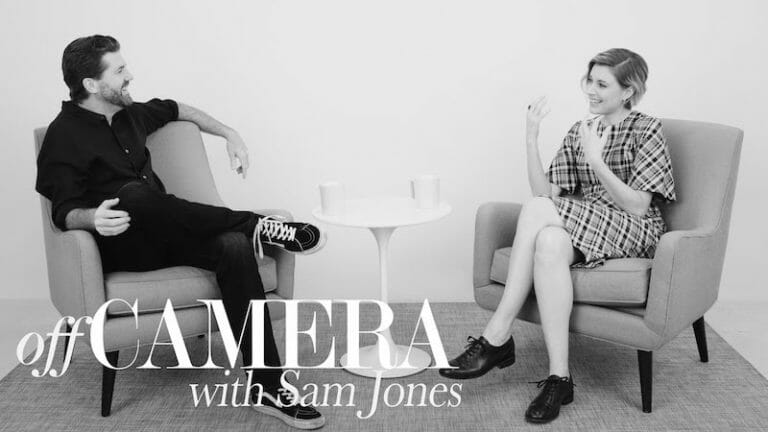Sign up for the
TSL Newsletter
and get $50 off Final Draft 12
By Ken Miyamoto · January 12, 2020

What are the best screenwriting tips from auteur Greta Gerwig (Lady Bird, Little Women)?
Download the screenplay for LITTLE WOMEN here for free.
Welcome to our ongoing Learning from the Masters and Industry Insiders series where we seek out and feature excellent videos, interviews, and discussions of the art, craft, and business of screenwriting and pull the best words of wisdom, writing tips, and screenwriting advice.
Here we turn to Off Camera with Sam Jones and feature the best moments from his interview with Greta Gerwig. We pull the best information from the video clips and elaborate on her points.
Many people believe that Gerwig’s movies are highly improvised, as far as the character dialogue she is so well known for. However, nothing could be further from the truth.
“The kind of writing I like is the kind of writing that one might think is improv… you use that improvisational impulse and then you set it. And then you make the thing.”
Dialogue is one of the most common struggles with novice screenwriters. You do your best to avoid the dialogue sounding wooden or on-the-nose, but that’s very difficult for most when they first start out.
The secret is to grasp that energy of improv and realistic exchange and recreate that through your own words. One way to accomplish that (not mentioned in Gerwig’s video) is to be more animated with your writing as you write dialogue. Act it out. Say it out loud to yourself. Play each character. Or create a hybrid of acting it out yourself and visualizing the scenario as a real moment in real-time — and then just write down what feels best.
Read More: The Oddly Relatable Characters in Greta Gerwig Movies
“I’m so interested in taking tropes from other movies and putting them in something where it doesn’t belong.”
Their discussion centered on the concept of taking what audiences know and have seen and placing those tropes and cliches into unfamiliar contexts. That’s what really offers Hollywood and the audience something familiar and something new at the same time — which is what most industry insiders are searching for in screenplays because that’s what audiences respond to most. They want to go watch familiar story and character types, but placed within new and original concepts and takes.
So many screenwriters struggle to learn story structure — but what you don’t realize is that it’s in your DNA.
“I think structure is so deep in us… we put it even in stories we tell our friends or in emails we write. We want it. It’s how we create meaning. So I feel like sometimes coming at it from an analytical way is like denying your birthright — which is story structure.”
There are so many different types of story structures that you can in your stories. There’s no single true answer to how to structure a screenplay — or any type of story. Yes, screenplays call for structures that fit within 90-120 pages, but it’s more organic than you think. And even cinematic story structure is embedded within our DNA after growing up watching television and movies. Trust your instincts and don’t be overly-analytical.
For all the latest from The Script Lab, be sure to follow us on Twitter, Facebook, and Instagram.
And become a member of TSL 360 to enjoy the LARGEST screenwriting education content library, featuring masterclasses, deep-dive interviews, and lectures from Academy Award-winning screenwriters, TV show-runners, producers, literary managers, agents, studio executives, and leading educators – all in one place.